#revolt of the batavi
Explore tagged Tumblr posts
Text

Brinno as leader of the Canninefates raised on the shield (Anno 70)
by Barend Wijnveld
#brinno#canninefates#shield#germanic#ancient rome#art#barend wijnveld#history#europe#european#antiquity#rhine#romans#rome#war#roman#batavia#germania#germanic tribes#revolt of the batavi#batavian rebellion#ceremony#ceremoniously#raised
81 notes
·
View notes
Text
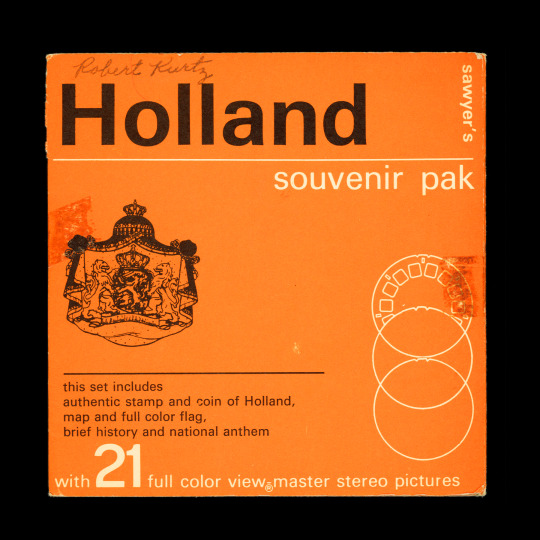
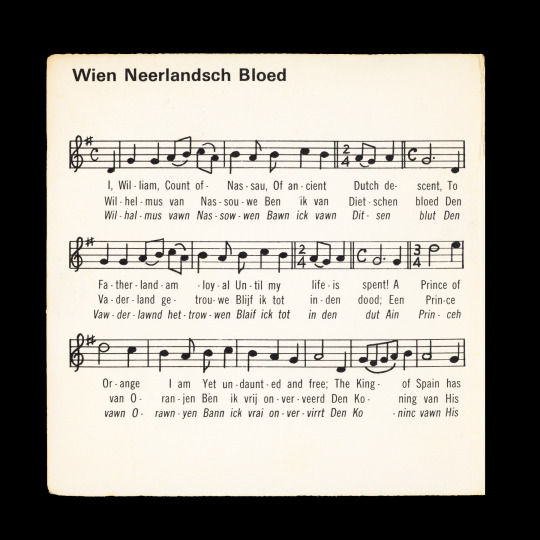
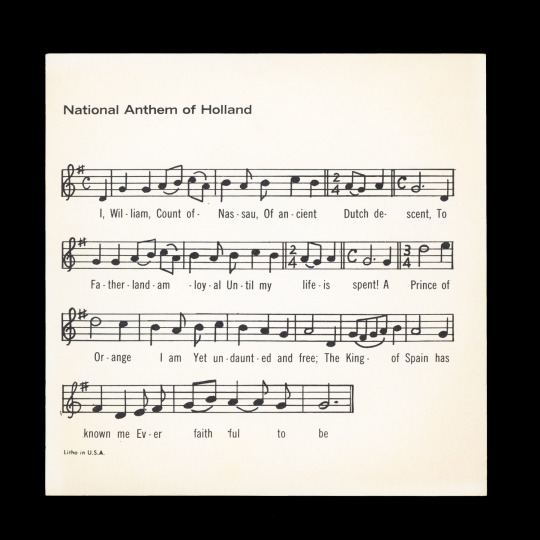


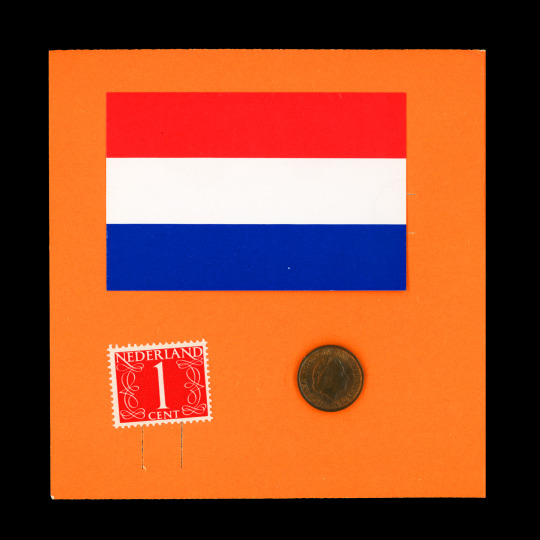
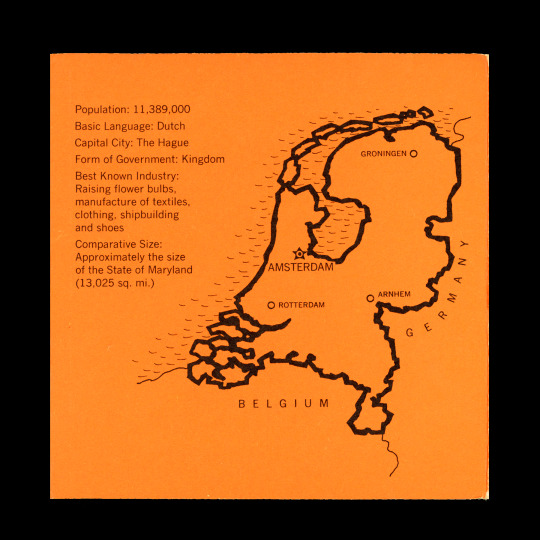






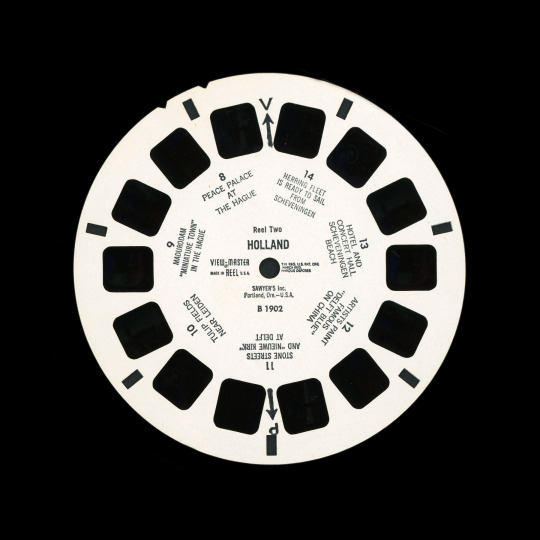


Brand: View-Master Company: Sawyer's Inc. Packet Title: Holland Packet Subtitle: N/A Packet Type: souvenir pak Packet Number: B 190 Packet Style: S5 Booklet: Included Reel Numbers: B 1901, B 1902, B 1903 Reel Edition: N/A Date: Undated Copyright: Sawyer's Inc.
souvenir pak Descriptions: Wien Neerlandsch Bloed - National Anthem of Holland
the story of Holland The 57½ million square miles of the earth would seem to most people a generous enough gift of nature and they would be content to leave it at that--but not the Dutch. With some ten million people crowded into an area no larger than tiny Massachusetts and Connecticut combined, they have boldly taken over where nature left off. With the aid of dikes and barriers of sand dunes they have added several million more acres of land to their country. More than half of the nation's population lives below sea level.
The earliest history of these people begins in about 55 B.C. when Julius Caesar, during his campaigns, found this area populated with Celtic and Germanic tribes such as the Belgai, Batavi, Frisians and Saxons. In 15 B.C. under Augustus, the territory was brought under Roman rule. During the third century a powerful Frankish tribe conquered many of the earlier tribes and the Frankish language (the official Dutch language now spoken in Holland) was generally adopted. The Franks accepted Christianity, but it remained for Charlemagne (742-814) to subdue the Frisians and Saxons and force them to accept this new religion.
Under feudal rule cities arose and petty disputes among the rulers enabled these cities to establish some measure of home rule. In the 15th century under Burgundian rule The Netherlands (which until 1830 included Belgium and Luxemburg) gained "The Great Privilege," a charter which greatly curtailed the sovereign's power in local matters. Then by marriage the country came under Spanish rule. The people rebelled and the long war which the Dutch waged against Spain (1468-1648) finally brought financial ruin to the Spaniards. Having freed themselves of Spanish restrictions, the Dutch grew rich with trade during the 17th century and acquired colonial holdings. But a century of decay followed and Holland lost much of its trade and some of its colonies.
In 1795 the country was conquered by the French. In 1815, following Napoleon's downfall, The Kingdom of the Netherlands was formed at the Congress of Vienna. The southern provinces, dissatisfied with this union, revolted, and to avoid a general conflict the great powers allowed them to form the separate Kingdom of Belgium. Luxemburg was lost when Queen Wilhelmina came to the throne in 1890 because its law did not then permit female rule.
During World War I the country remained neutral, but in World War II the Germans invaded Holland. Queen Wilhelmina fled to England to carry on the government-in-exile. Dutch resistance lasted only five days, but the German wholesale, systematic destruction of the country left Holland in ruin. The recovery of this country from the war has been remarkable. The government of Holland, now with Queen Juliana as its sovereign, is a constitutional monarchy. Amsterdam is the constitutional capital, but the actual seat of government is in The Hague. The kingdom includes the Netherlands Antilles, Surinam and the western half of New Guinea. Rotterdam, located at the mouths of the two great rivers, the Rhine and the Meuse, is the biggest port in the world next to New York. Amsterdam, the largest city in Holland, rivals Antwerp as diamond-cutting center of the world. A network of 50 canals carves the country into hundreds of tiny islands which are connected by 400 bridges. Bicycles are the major form of transportation and outnumber cars about six to one. This low, flat land has a maritime climate—cool and damp—and strong winds blow steadily from the North Sea. Holland's natural resources are limited and the country imports many raw materials which are processed into finished products for export. Because of its geographical position and excellent harbor, Holland has developed into a great trading, transporting, and brokerage nation.
To foreigners Holland is symbolized by tulips, windmills, picturesque costumes and the quaint story of a boy with his finger in the dike. Tulips they have (and hyacinths) in countless numbers and the sale of bulbs is a serious and thriving business. The windmills are gradually being replaced by steam or electrically driven pumps. There are towns where local costumes are worn, but for the most part the Dutch are as up to date in their dress and ideas as any country on earth. As for the fanciful, fictional tale of the boy who held his finger in the dike all one night and saved his people from the sea, the Dutch--out of politeness to tourists—have erected a statue in his honor. But, as one official puts it, "Polite we are but quaint we ain't."
Population: 11,389,000 Basic Language: Dutch Capital City: The Hague Form of Government: Kingdom Best Known Industry: Raising flower bulbs, manufacture of textiles, clothing, shipbuilding and shoes Comparative Size: Approximately the size of the State of Maryland (13,025 sq. mi.)
#sawyer's inc.#viewmaster#view-master#holland#international packets#travel packets#b 190#b 1901#b 1902#b 1903#S5 packet#souvenir pak
2 notes
·
View notes
Note
9, 12 and 33 for your 50 followers event if that's not too much. 💙
It's not hun!
9 What's your favorite scene in KNB? Hmm, that's actually a bit of a difficult question but I feel like the scene in which Midorima has those tiny flashbacks about his team in the Shutoku vs Rakuzan game, and realizes what they have came to mean to him is very dear to me.
Not just the character development itself, but the stark contrast it paints between him and Akashi too. Akashi and Midorima have a dynamic that really interests me (and I have a few love triangle fics with these two stored). They were amongst the closest friendship pairs in the GOM, had similar enoug backgrounds and lead the Teiko team together as Captain and Vice Captain. Yet their philosophies couldn't be anymore different when it comes to teamwork, even during their Teiko days. Let's not forget, Midorima was the only one out of the GOM who never wanted to participate in things like quotas and betting and after Akashi's personality switch, he was the only GOM who never skipped out and continued training hard. Midorima always thought winning was important, but he believed in neither high pressure, or slacking. Then, after joining Shutoku and being defeated by Kuroko, he basically is the GOM to follow directly into Kuroko and Kagami's footsteps by finding his own 'shadow' in Takao. Meanwhile, Akashi would toss his teammates aside, would put them under high pressure yet allowed them to slack simultaneously. It feels like such an epic showdown of the differences between them as players and the friends they once were. Midorima was defeated, but he stood up to Akashi and made his point. Not a lot of people would have had the balls to do that.
12, Is there any historical event you'd like to witness?
As a history buff, there are plenty I'd like to witness! One high on my list would be the Revolt of the Batavi. I mentioned growing up on the Dutch countryside as a child, and it was actually the province where the revolt took place so it's a very important historical event to our region. (short summary, the Batavi were a Germanic tribe the Roman Empire had basically overtaken in their quest to conquer North Europe. The Batavi had a revolution against them, it failed but the Batavi had birthed an ideology that said, 'if all of our tribes were to stand together we could defeat the Romans'. And sure enough, this was the starting point of the downfall of the Roman Empire as the other tribes had listened to the Batavi). 33, What's the most recurring theme in your dreams? YA worthy plots surrounding other worlds. I often have dreams surrounding cities I've been, but there are entirely different buildings, streets, etc yet my dreams are consistent as if there's really an alternate universe out there were there's a huge theme park behind the central station of Berlin.
Another very frequent thing that happens in my dreams is the end of the world, where I get eaten by a monster or alien at some point. Sometimes, I even dream to the point where everything has been destroyed, I am dead and the world is beginning anew. Like Ragnarok from Norse Mythology.
Just last night, I had another weird ass dream that involved a magical world with pink trees. I suppose my sub-conscious is really invested in world building LMAO
#50 followers#questions#dreams#history#knb#akashi#midorima#my brain is obsessed with world building and alternative dimensions
12 notes
·
View notes
Photo




Cologne During The Batavi Revolt
In the year 70AD, during the Batavi revolt, Civilis managed to capture Castra Vetera, a Roman fort in modern day Xanten. He promised the Roman soldiers free passage out but the Germanics attacked them only a few kilometers outside of the fort and destroyed the Roman garrison. The most important Roman officers were captured and gifted to Veleda, the unmarried and deeply respected seeress, for she predicted that the Batavi would win this revolt.
Civilis was spurred on by his success to move towards Agrippina, (Rome already lost two legions by now because of this revolt) but he was hesitant to let the Germanics plunder the Roman city of Colonia Claudia Ara Agrippinensium (modern day Cologne, Germany).
Plundering the city would not be good for Civilis' reputation and at the start of the Batavi rebellion, his son was captured and treated with honour in Agrippinensium. But this Roman city was however hated by the tribes above the Rhine. The Tencteri sent envoys into Agrippina in order to let their demands be known. The fiercest of the Tencteri spoke and delivered one hell of a speech:
"You belong to the greater part once more, you are Germanic again! We therefore thank all of our Gods and Tyr, our main God, and congratulate you. Finally you shall be free amongst the free. Until today the Romans closed off the rivers, land and in a certain way the sky, to stop all contact and traffic with us. Or it was to humiliate, us men born for weapons, further. Unarmed, practically naked, we would live under supervision and meet for a fee.
But so that our friendship and alliance may be everlasting, we demand that you tear down the walls of your colony, the bulwark of your slavery (even wild animals forget their virtue when locked up), that you slaughter all Romans within your bounderies. Freedom and slave masters do not easily mix. Let the goods of those killed be coded into a common store, so that no one hides anything or separates his own interest.
We and you must have the right to settle on either bank of the Rhine, as our forefathers did in the past. Nature has granted every man the privilege of light and day, not less has she given brave warriors access to every land.
Take back the traditions and customs of your own land again and cast out this luxery. This comfort gives the Romans more power over their subjects than their weapons! In this way you become a pure and unspoiled people, you forget slavery and become equally entitled, if not more powerful than others."
The inhabitants of Agrippina however couldn't accept or refuse these demands. They replied as follow:
"When the first opportunity for freedom was given, we took it up more eagerly than cautiously, so that we would be joined to you and all other Germanics, our kinsmen.
This is the fatherland for those colonists who at one time came and united with us by marriage and for those who were the offspring soon after. We do not judge you to be so prejudiced that you would wish our fathers, brothers and sons to be killed by us."
The citizens of Agrippina exclaimed to be supportive of the Germanic cause but refused to kill the Roman colonists for they already married and had families with Germanic people, they couldn't possibly kill their own families.
They allowed the Germanics free entrance through the city but only when they were unarmed. Further they wanted to confirm the agreements with Civilis and Veleda. This is how the citizens of Agrippina managed to calm the Tencteri down and prevent the plunder of the city. In return the city would join Civilis and his Batavi revolt.
This speech and the recorded events were written down by Tacitus. Pictures of: Colonia Agrippina, Statue of Civilis, Embroidered depiction of Civilis from the 1800s, Map that shows the location of Agrippina in 70AD,
18 notes
·
View notes
Text

Claudius Civilis leads the Batavian revolt - Uknown date/artist
"Claudius Civilis leads the Batavian revolt. The Revolt of the Batavi took place in the Roman province of Germania Inferior (S. Netherlands) between AD 69 and 70. It was an uprising against the Roman Empire started by the Batavi; a small but militarily powerful Germanic tribe."
-taken from fotolibra
https://paganimagevault.blogspot.com/2020/05/claudius-civilis-leads-batavian-revolt.html
#the batavian revolt#pagan#europe#european art#paganism#sketch#art#dutch history#german history#roman empire#history#claudius civilis
11 notes
·
View notes
Photo




Gladius Sword Blade and Scabbard Mounts from Wiesbaden, Germany dated between 50-100 CE on display at the Royal Armouries in Leeds
This Roman sword, or Gladius, is of the “Pompei Type” (named after an example found at Pompei) and the blade bears the name of its owner, a legionary, Caius Valerius Primus. Presumably he fought in the Germanic Wars in either the Revolt of the Batavi (69-70 CE) or the Emperor Domitian’s Campaigns against the Chatti (82 CE). The parallel two-edged blade, with reinforced tip, was primarily designed for thrusting at close quarters, and illustrates the quote:
“Puncta duas uncias adacta mortalis est” (A stab wound two inches deep is fatal) - Vegetius
Swords, like this, were used by infantry legions and normally worn high on the right side so as to be clear of the legs. The wooden sheath, originally covered in leather, has decayed but the tinned bronze scabbard mounts survived. These include two decorated panels, the upper showing a helmeted warrior (Mars?) holding a spear and shield, the lower a winged Victory writing on a shield.
Photographs taken by myself 2019
#archaeology#military history#sword#roman empire#ancient#1st century#iron age#germanic wars#german#germany#art#royal armouries#museum#leeds#barbucomedie
419 notes
·
View notes
Photo
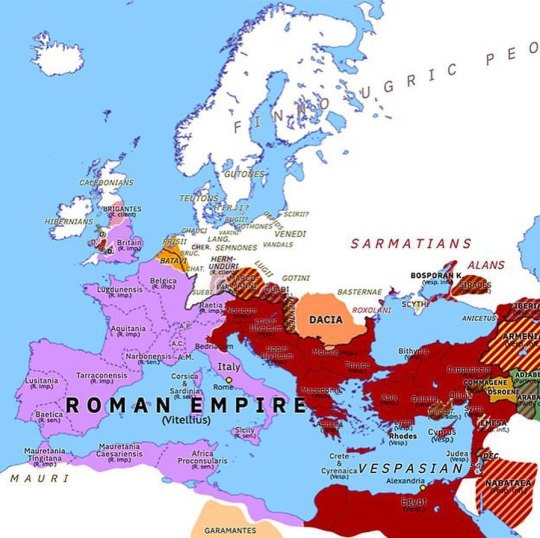
NEW MAP: Europe 69: Revolt of the Batavi (24 Oct 69 AD) https://buff.ly/2p3l7rY In August 69 the Danube legions declared for Vespasian (in Egypt), invading Italy and defeating the Roman emperor Vitellius at the Second Battle of Bedriacum in October. Meanwhile, on the Rhine, the Batavi and allied tribes—including many veteran auxiliary troops—rose up against Vitellius’ attempts to forcibly conscript them, defeating two Roman legions. The Batavi held out for a year, finally surrendering to Vespasian’s forces in 70 AD. #ancient #ancienteurope #ancientrome #romanemperor #vespasian #batavi #belgium #cartographer #cartography #dutchhistory #europe #europeanhistory #historicalplace #historie #historygeek #historymaker #historymatters #instahistory #map #maps #nederlands #netherlands #roman #romancivilwar #romancivilwars #romanempire #romanhistory #romans #worldhistory #newmap (at Xanten) https://www.instagram.com/p/B4CGSvwAy-Z/?igshid=841ztdrvfaxa
#ancient#ancienteurope#ancientrome#romanemperor#vespasian#batavi#belgium#cartographer#cartography#dutchhistory#europe#europeanhistory#historicalplace#historie#historygeek#historymaker#historymatters#instahistory#map#maps#nederlands#netherlands#roman#romancivilwar#romancivilwars#romanempire#romanhistory#romans#worldhistory#newmap
13 notes
·
View notes
Note
for the questions thing; roses and starlet :)
Roses: what does love feel like to you? describe it!
The feeling when you wake up naturally in the morning and the sun is shining on your bed and you have nowhere to go and you kind of stretch out in the sunpatch like a cat. A sort of absolute contentment that you can feel in your chest.
Starlet: what historical period is most interesting to you?
Early Dutch/Germanic history is super interesting to me, particularly the interaction of the Germanic tribes with the Roman empire (like the revolt of the Batavi). Also the time of the Frisian and Frankish kingdoms, like King Redbad/Radboud (fun fact there’s a movie currently in production about him and a bunch of my friends are in it as fighters).
5 notes
·
View notes
Text

willkommen-in-germany: The Frisians (German: Friesen) are a...
The Frisians (German: Friesen) are a Germanic ethnic group native to the coastal parts of Northern Germany and the Netherlands. They inhabit an area known as Frisia and are concentrated in the Dutch provinces of Friesland and Groningen and, in Germany, East Frisia and North Frisia (parts of which belonged to Denmark until 1864). The Frisian languages are still used by 500,000 speakers. Dialects of Frisian are recognized as official languages in both Germany and the Netherlands.
The ancient Frisii enter recorded history in a Roman account of the 12 BC war against the Rhein Germans and the Chauci. They appear in accounts of Roman wars against the Germanic tribes of the region, up to the Revolt of the Batavi around 70 AD. Frisian mercenaries were hired to assist the Roman invasion of Britain in the cavalry. They’re not mentioned again until 296, when they were deported into Roman territory as laeti (= serfs). The discovery of a type of earthenware unique to 4th century Frisia (terp Tritzum) shows that a number of them were resettled in Flanders and Kent, probably as serfs. From 200-400 AD, Frisia suffered marine transgressions that made most of the land uninhabitable, aggravated by a change to a cooler, wetter climate. The population dropped dramatically, and coastal lands remained largely unpopulated for the next 2 centuries. When conditions improved, Frisia received an influx of new settlers, mostly Angles and Saxons, who intermarried with the earlier population. These people would eventually be referred to as Frisians, though they were not necessarily descended from the ancient Frisii. It’s these new Frisians who are largely the ancestors of the modern Frisians.
By the end of the 6th century, Frisian territory had expanded westward to the North Sea coast and, in the 7th century, southward down to Dorestad. This farthest extent of territory is sometimes referred to as Frisia Magna. Early Frisia was ruled by a High King, with the earliest reference dated 678. In the 8th century the Frisian nobles came into increasing conflict with the Franks to the south, resulting in a series of wars in which the Frankish Empire eventually subjugated Frisia in 734. These wars benefited attempts by Anglo-Irish missionaries (e.g. Saint Boniface) to convert the Frisians to Christianity. Sometime after the death of Charlemagne, Frisian territories were technically under the control of the Count of Holland, but in practice the Hollandic counts, starting around 993, were unable to assert themselves as the sovereign lords. This resulted in a period called the Frisian Freedom, in which feudalism and serfdom along with central or judicial administration did not exist, and in which the Frisian lands only owed their allegiance to the Holy Roman Emperor. In the 13th century, the counts of Holland became increasingly powerful and, starting in 1272, sought to reassert themselves as rightful lords of the Frisian lands with more wars, which ended in 1422 with the Hollandic conquest of Western Frisia and the establishment of a more powerful noble class. In 1524 Frisia became part of the 17 Provinces, and in 1568 joined the Dutch revolt against Philip II of Spain. Central Frisia has remained a part of the Netherlands since, while the eastern end became part of various German states and Denmark.
Language. Old Frisian is the most closely related language to Old English; modern Frisian dialects are in turn most closely related languages to contemporary UK English. The Frisian language group is divided into 3 mutually unintelligible languages: West Frisian (in Dutch province of Friesland), Saterland Frisian (in German municipality just south of East Frisia), and North Frisian (in the German region of Nordfriesland on the west coast of Jutland). Of these 3 languages both Saterland (2,000 speakers) and North Frisian (10,000) are endangered. West Frisian is spoken by ~354,000 native speakers and is not yet threatened.
Identity. Today there exists a tripartite division of the Frisians, into North, East, and West Frisians, caused by constant loss and changes of territory in the Middle Ages. The West Frisians of the Netherlands generally don’t see themselves as part of a larger group of Frisians - according to a 1970 poll, they identify themselves more with the Dutch of the Netherlands than with the East or North Frisians on the German side. Therefore, the term Frisian, when applied to its speakers of all 3 Frisian languages, is a linguistic and possibly cultural concept, not a political one. Culturally, modern West Frisians and Northern Dutch are rather similar, the main difference being that West Frisians speak West Frisian, alongside Dutch. Because of centuries of cohabitation and active participation in Dutch society, as well as being bilingual, these Frisians are not treated as a separate group in official statistics of the Netherlands. The same applies in Germany.
0 notes
Text
The Revolt of the Batavi: Ancient Times
The Revolt of the Batavi: Ancient Times
The Revolt of the Batavi took place in the Roman province of Germania Inferior between AD 69 and 70. It was an uprising against the Roman Empire started by the Batavi, a small but militarily powerful Germanic tribe that inhabited Batavia, on the delta of the river Rhine.
They were soon joined by the Celtic tribes from Gallia Belgica and some Germanic tribes.
Under the leadership of their…
View On WordPress
0 notes
Text
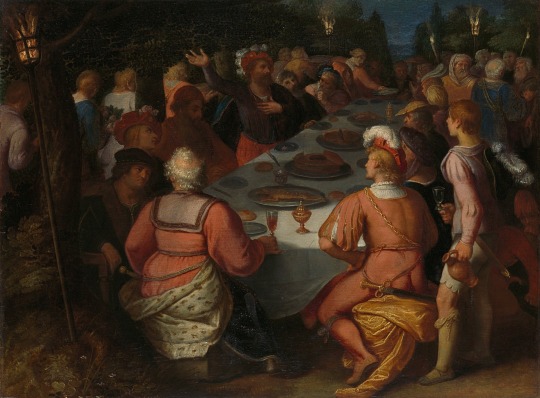
The Conspiracy of Claudius Civilis and the Batavians in the Schakerbos | The Conspiracy of Julius Civilis and the Batavians in a Sacred Grove
by Otto van Veen
#julius civilis#claudius civilis#batavians#revolt#batavi#art#painting#history#europe#european#otto van veen#conspirators#conspiracy#roman empire#province#sacred grove#germania#germanic#tribes#uprising#netherlands#holland
15 notes
·
View notes
Photo

An allegorical representation of the Dutch fight for independence using the Batavian Revolt against the Romans in 69 CE.
(Rijksmuseum)
#Revolt of the Batavi#Eighty Years' War#00s#art#1500s#1600s#Batavi#renaissance warfare#ancient warfare#History#Military History#War#Military
28 notes
·
View notes
Text
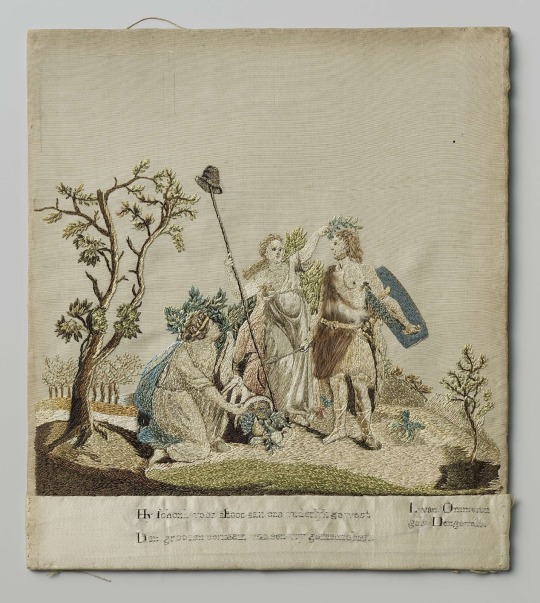
Embroidered Picture of Claudius Civilis by Louise van Ommeren 1800 Rijksmuseum
"The Rijksmuseum in Amsterdam houses an embroidered picture (21.9 x 19.5 cm) with an allegorical representation of Claudius Civilis (Gaius Julius Civilis), the reputed leader of a revolt by the Batavians against the Romans in the first century AD. The Batavians were long regarded as the ancestors of the Dutch (compare the name of Batavia for the former capital of the Dutch East Indies, nowadays called Jakarta). The embroidery was made by Louise van Ommeren, née Hengevelt, sometime around 1800. The picture shows a Batavian (Batavier in Dutch) clad in fur who is being honoured by a personification of Freedom. She holds a laurel wreath with her left hand, and a lance with a 'freedom hat' with her right hand. To the left is another figure, who is positioned kneeling next to a basket full of flowers and fruit, symbolising the cornucopia. The embroidery can be placed in the context of the social and political upheavals in The Netherlands at the end of the eighteenth and the early nineteenth centuries, when the patriotten ('patriots') rose against the establishment led by Prince Willem V of the House of Orange. The new republic that was established in 1795, when the French had invaded and occupied the Netherlands and the patriotten for a short time gained the upper hand, was renamed De Bataafsche Republiek ('The Batavian Republic'), after the alleged ancestors of the Dutch. The new Republic lasted until 1801, when the constitution, under French pressure, was changed and the country was renamed Het Bataafsch Gemeenebest ('The Batavian Commonwealth'). In 1806 The Netherlands were made into a monarchy; the first king was Louis Napoleon, younger brother of Napoleon and the father of the future Napoleon III. The picture is accompanied by an embroidered text on a separate piece of material, applied to the embroidered picture: Hij schonk voor altoos aan ons vaderlijk gewest / Den grooten eernaam van een vrij gemeenebest ('He granted for ever to our fatherland, the grand honourable name of a free commonwealth')."
-taken from trc-leiden.nl
#the batavian revolt#dutch history#german history#embroidery#europe#european art#the netherlands#dutch#pagan#paganism#history#art#19th century art#claudius civilis#rijksmuseum
7 notes
·
View notes
Photo
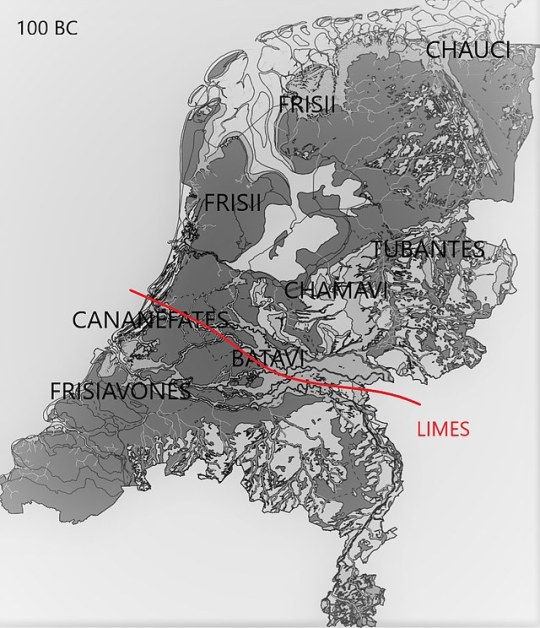

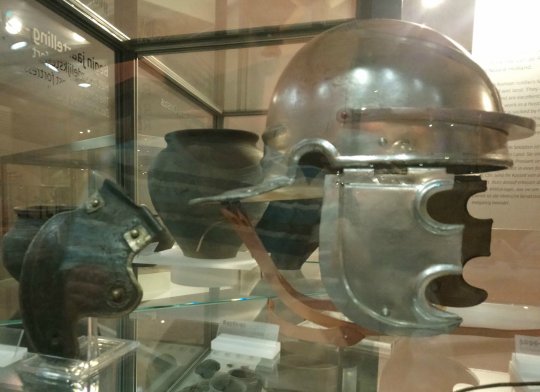

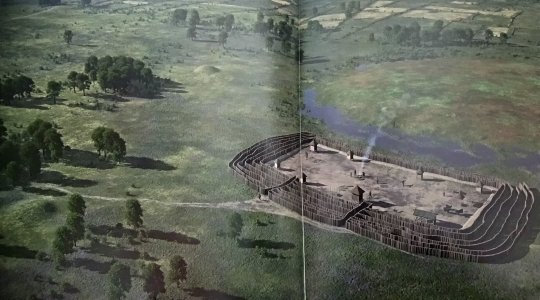

Frisii
This is a rewritten post on the Frisii tribe, my previous post is over a year old so I wanted to update it by adding more information.
The Frisii were a Germanic tribe who lived above the Rhine in areas that are now known as modern day Noord-Holland, Friesland, Groningen, the Wadden islands in the Netherlands and East-Frisia in Germany. They should not be confused with the Frisians, a tribe which settled in the same area at a later time period, The Frisians and Frisii are however not completely foreign to each other, some Frisii stayed behind and were absorbed by the Frisians, the oldest still existing Germanic culture. The Frisii were neighboured by the Cananefates to the south and Chauci to the east, the west and north were part of the north sea.
The meaning of their name is derived from the Proto-Germanic word 'frisaz' which means 'curly'. There is a common misunderstanding that the word Frisii, and the later Frisian, comes from the word freeze/vriezen or freedom but this is not correct although understandably a good possible meaning.
The origins of the Frisii is still a bit unclear but there are viable theories. Unlike other tribes, like the Chatti, Lombards, Batavi, Cananefates etc.. who all migrated southwards and settled in their territories around 100BC, the Frisii are a lot older. In fact we do not know how old exactly they are but there are several theories:
The most likely theory is that the early Frisii, also called Proto-Frisians, migrated southwards from northern Germany and Denmark around 1000BC. Somewhere around 700BC they migrated from modern day Drenthe towards modern day Friesland, Groningen and Noord-Holland. There is however a more controversial theory that suggests the birth of the Frisii started with their patron-mother the Goddess Freya.
According to this theory a line of matriarchal rulers, known as folk mothers, were descendants of Freya herself and responsible for the creation of the Frisii, this would mean that the origin of the tribe is not around 700BC but around 2200BC. Here is a line of Frisii folk mothers starting with the Goddess Freya: Freya - somewhere around 2000BC Fasta, Medea, Thiania, Hellenia, Minna, Rosamond, Hellicht, Frana, Adela and Gosa. Of course if there was a continuous matriarchal line for about 1500 years long, this would include many more names but those are lost in time. This theory is based on the information found in the Oera Linda book, a highly disputed manuscript worthy of its own post so I will write about it in the near future. An altar stone has been found near modern day Xanten however with the following description: "MATRIBUS FRISAVIS PATERNIS" which could refer to these ancient Frisii matriarchs making the Oera Linda book theory possible.
By 100BC the Frisii were quite a large and powerful tribe who had established themselves fully in their current territory. Their first encounter with the Roman empire was around 12BC when Drusus Germanicus, one of Rome's most succesful generals, invaded Germania with the intention to turn the land into a province of Rome.
Drusus Germanicus, not to be confused with the other Roman general called Germanicus, was incredibly succesful with his invasion. He subjugated every Germanic tribe in his path including the Frisii who were forced to be allies of Rome. The Romans also built a fort, their most northern one, at modern day Velsen to keep an eye on the Frisii. It is likely that all of Germania would have become a Roman province if Germanicus didn't die after a fall from his horse in 9BC.
The Frisii delivered auxiliary troops to Rome and they had to pay taxes which led to high tensions between the tribe and Rome. The taxes were incredibly unfair as the Romans demanded large skins of cows which did not even exist in Frisii territory, they only had a small breed of cows. This rising tension eventually led to the Frisii revolting against Rome in 28AD. The Frisii hung Roman tax collectors which infuriated Rome.
Olennius, a Roman centurion in charge of Frisii administration, escaped the lynching party and hid himself at Castellum Flevum, the most northern fort the Romans ever built. The Frisii however marched onwards to this fort but were unable to capture it, archeological research shows traces of heavy fighting at this fort. The Frisii retreated back towards their sacred grove dedicated to their Goddess of war, Baduhenna, luring the Romans with them.
The Romans chased the Frisii right into the sacred grove. This was however a dreadful decision since the Frisii knew their swampy estuary terrain very well and were extra motivated by being in the presence of their battle Goddess. Almost all of the Romans were slaughtered, 900 of them, some according to legends, were captured and sacrificed to Baduhenna right in her grove. Another 400 Roman soldiers killed each other out fear of treachery, the event has been quoted by Tacitus:
"Soon afterwards it was ascertained from deserters that nine hundred Romans had been cut to pieces in a wood called Baduhenna, after prolonging the fight to the next day, and that another body of four hundred, which had taken possession of the house of one Cruptorix, once a soldier in our pay, fearing betrayal, had perished by mutual slaughter." - Tacitus
The Frisii name thus became famous in Germania and Roman emperor Tiberius tried to keep the Roman defeat a secret, not wishing to entrust anyone with the war because of the shame. The Roman fort in modern day Noord-Holland was abandoned after the revolt and the Frisii became free people once again and remained so until the medieval ages.
The earliest known written record that we have about the Frisii comes from a Roman poet Albinovanus Pedo. In one of his poems, he describes a disaster that occured during Germanicus' campaigns to avenge the Teutoburgerwald battle. This disaster took place around the Eems river in Frisii territory around 16AD and involves a storm destroying parts of his fleet:
"For a long time they had left the day and the sunlight behind them, for a long time they looked exiles from the well known part of the world, who had dared to go through forbidden darkness to the boundaries of nature and the furthest coast of the earth.
From here they saw him, the sea, carrying huge monsters under slow waves with rising wild whales and the dogs of the sea on all sides grabbing ships. The fleet was already in the mud, left behind by a rapid storm. They believed that their unfortunate fate was to be torn apart by these wild sea monsters.
The world was robbed, nothing could be distinguished, his breath was taken from him, and thus he spoke from his heart: Where do we end up? The day itself is fleeing and nature closes the rest of the world with eternal darkness. Do we sometimes look for people untouched by wars? The gods call us back, forbid that mortal eyes see the end of everything. Why do we violate a strange and consecrated sea with oars? Why do we disturb the silent dwellings of the gods?" - Albinovadus Pedo
The next written mention is quite an interesting one. It involves a dispute about land on the Roman border area. Two Frisii leaders, Verritus and Malorix decided to travel to Rome in 58AD and defend their case about this piece of land. During their stay in Rome, they amused the Romans greatly by refusing to sit down amongst the common people in a theater exclaiming that: "No people can match the Germanics in loyalty and bravery!" They then proceeded sitting down next to the Roman senators present in the theater. The Roman emperor, Nero, found the whole event quite amusing himself and granted Verritus and Malorix roman citizenship. This account, described by Tacitus, is also the first account of foreign tourists visiting Rome who were mentioned by name.
In 69AD, during a particulary tough year for the Romans, the Batavi revolted against the Roman empire. The Frisii joined this revolt which was initially quite succesful. Unfortunately the revolt was put down by the Romans the following year, resulting in severe trust issues between the Romans and the Batavi and Cananefates.
By 98AD Tacitus published his work 'Germania' and also provices us with a small description on the Frisii. He separated the tribe in two parts, the Frisii Maiores and the Frisii Minores. The Minores lived in what is now Noord-Holland and the Maiores lived in what is now Frisia and Groningen. Here is a description on the Frisii landscape:
"The terrain is fierce, the climate is rough, life and landscape are bleak. You only come here if it's your homeland." - Tacitus
No significant recorded events exist after 98AD, the history on the Frisii between 100AD-300AD is pretty much unknown. We do know that parts of the Frisii joined the Cananefaat pirate/proto-viking Gannascus in his raids on several settlements, mainly in Gaul. These attacks infuriated Rome and led to improved defenses being built by them. Gannascus is eventually assassinated by the Romans under the pretence of a negotiation which caused great outrage amongst the Chauci, Frisii and Cananefates. The Roman emperor of that time, Claudius, feared a violent conflict with these tribes and withdrew Roman forces from the Rhine in order to ease tensions.
Around 300AD the Saxon confederation came into existence and bordered the Frisii directly to the east. The Western Roman empire started to decline rapidly during this time period as well leaving the borders vulnerable for invasions. With the Huns invading Europe, economic hardship, climate change, failed harvests and empty Roman borders, came the great migration. Many Frisii migrated either southwards to become absorbed by the Franks or to the west by invading Britannia together with the Angles, Saxons and Jutes. Only very few Frisii remained in their original homeland, we have archeological evidence that some did indeed stay.
Frisii lands were now almost completely deserted until the arrival of Saxons and Jutes who settled the area together with the few remaining Frisii. These new settlers started to call themselves Frisians, after the ancient Frisii. The Frisians still exist until this day and they have a rich history which deserves a post of its own, which will be coming very soon.
The last thing I want to mention is the auxiliary troops that the Frisii supplied Rome with. The Notitia Dignitatum, a Roman document that describes details of the administrative organisation of the empire, mentions a Frisii cohort stationed at Vindobala, a fort located at Hadrian's wall. This entry 'Tribunes cohortis primae Frixagorum Vindobala' however contains a possible spelling mistake, Frixagorum instead of Frisiavonum. This entry might however also refer to the Frisiavones tribe unrelated to the Frisii.
Here are images of: A map showing the location of the Frisii, A reconstruction of Castellum Flevum, A depiction of the Frisii fighting Romans by an unknown artist, A reconstruction of a Frisii fortification, A small piece of a Roman helmet, bottom left, found at Velsen where once the Castellum Flevum stood which was attacked by the Frisii, A depiction of the Goddess Freyja, the ancestral mother of the Frisii, from 1874,
91 notes
·
View notes
Photo
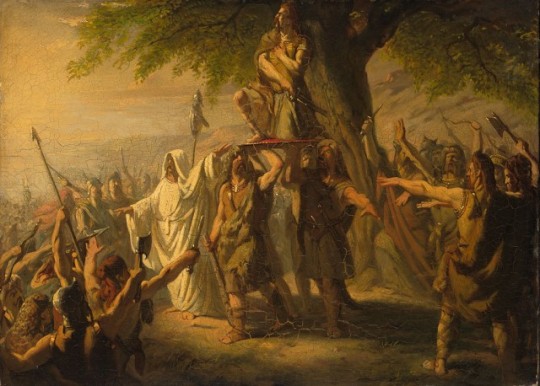
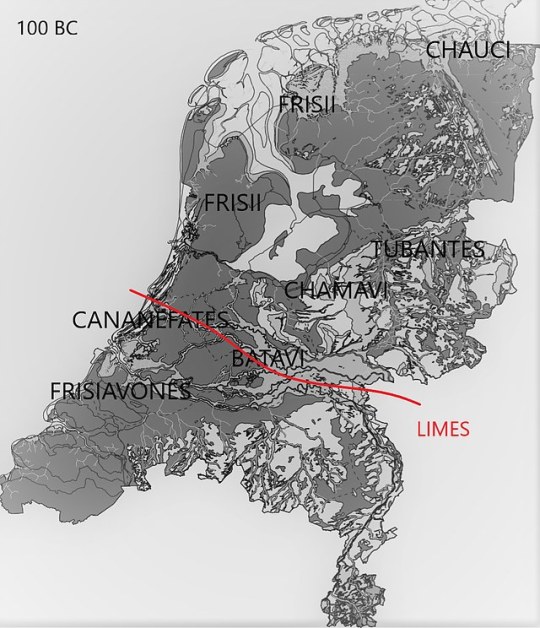

Cananefates
It has been over a year since I have written a post on the Cananefates tribe. I have rewritten the post to include more information since it was quite a short post. This tribe is personally one of my favourites because I currently live in former Cananefates territory and so have my ancestors for about a 1000 years, at least as far as my family tree goes back.
The Cananefates were a Germanic tribe located in modern day Zuid-Holland, the Netherlands in the Rhine delta. Their neighbours to the east were the Batavi, to the south the Frisiavones and to the north the Frisii. They obviously had no neighbours to the west because they lived on the coasts of the north sea.
The name of this tribe is a bit strange and the origins of the Cananefates people is also not fully clear. There are two possible theories: one theory suggests that the Cananefates are actually a small splinter group of the Batavi, the other theory suggests that both the Batavi and Cananefates broke off the Chatti after an internal conflict. The only thing that is sure is that the Batavi and Cananefates were related to each other. Another completely different theory suggests that the Cananefates were perhaps Celtic in origin but adopted the Germanic culture or the other way around.
Several reasons to support the last theory is the name of the tribe. The word Cananefates means 'master of leeks', the first half of the name is Celtic and the latter Germanic. The meaning is quite curious because it isn't really that much of a heroic name compared to most other Germanic tribes. It does however suggest that they were very skilled at farming.
The first Roman who recorded the existence of this tribe was Julius Caesar in his work 'De Bello Gallico'. He describes how the Batavi and Cananefates live on an island in the Rhine delta. Another Roman who gave a more detailed description of the Cananefates was Tacitus. He described the Cananefates as a tribe smaller than the Batavi but they equalled the Batavi in their skills of war. Just like the Batavi, the Cananefates supplied the Roman army with auxiliary units and some even served as imperial bodyguards.
Despite being only a small tribe, the Cananefates have accomplished fairly great things, one example is the story of Gannascus, the Cananefaat who terrorized coastal settlements with raids, he's considered to be one of the earliest proto-vikings. I have written a seperate article about his life for those who are interested. Another unknown Cananefates auxiliary officer was present at Caligula's infamous attack on the sea. An event that the Cananefates would never forget.
The most famous Cananefaat was Brinno, a chief of the tribe. The Cananefates and Batavi were not only related to each other but they were close allies as well. When the Batavi revolted in 69AD, Brinno called upon his tribe to join the revolt against the Romans. Tacitus has described Brinno in his work 'the annals' as following:
"Among the Cananefates was a foolish desperado called Brinno. He came from a very distinguished family. His father had taken part in many marauding exploits. The mere fact that his son was the heir of a rebel family secured him votes. He was placed upon a shield in the tribal fashion and carried on the swaying shoulders of his bearers to symbolize his election as leader.
Immediately calling upon the Frisians, a tribe beyond the Rhine, he swooped down on two Roman auxiliary units in the nearby quarters and simultaneously overran them from the North Sea. The garrison had not expected the attack, nor indeed would it have been strong enough to hold out if it had. So the posts were captured and sacked." - Tacitus, the annals
If you want to know more about Brinno, I have written a post about him as well.
Besides all their military accomplishments, their most unique trait was farming. The tribe's name rightfully means 'master of leeks' because the Cananefates had the most ingenious farming system of all the Germanic people and perhaps of all Western Europe. In Vlaardingen, Netherlands, certain valves were found dating back to 100AD. These valves were used to direct water to a specific direction. They built dams and used these valves to direct water away from the crops during high tides and heavy rains. This is the oldest sluice system of Western Europe.
The Cananefates were perhaps also the Germanic tribe with the most Roman influences. When the Romans encountered this tribe, the Cananefates were still living in tiny hamlets consisting of a few farms. By 130AD the Cananefates had a capital city, Forum Hadriani, with a typical Roman layout and streets made of brick. Their temples looked exactly the same as classic Roman temples, although they were smaller.
Unfortunately nothing much more is known about this tribe after 170AD. We know that the Cananefates continued raiding coastal settlements to the great annoyance of the Romans. Together with the Chauci and Frisii, they truly terrorized towns across Gaul and Britannia causing the Romans to drastically improve their defences.
Eventually the Cananefates were absorbed by the Franks around 350AD, it is also very much so possible that the Cananefates were one of the tribes who were responsible for the formation of the Frankish confederation.
The Cananefates supplied Rome with soldiers, some records of these soldiers and their units have survived. We know per example that the Cananefates and Batavi always had a combined force of about 5000-6500 men serving in the Roman army and that the Cananefates supplied Rome with 24 new recruits each year, the Batavi 240 new recruits. We also know that there was one Cananefates auxiliary cavalry unit and that this unit was also involved in the Frisii uprising. They suffered heavy losses at the battle of Baduhenna grove.
Initially the Cananefates auxiliary were deployed close to their homelands, such as during the Frisii revolt. But the Romans lost their trust in the Cananefates after the Batavi revolt so after 69AD, the Cananefates were deployed far away from their homeland in modern day countries like Romania, Hungary and Algeria.
Another interesting little fact is that the Roman influence did not only extent into Cananefates architecture, religion and military. Quite some family members of Cananefates, and also Batavi, auxiliary troops were literate. Even in the lower classes, many women, whose husbands were serving in the Roman army, were able to write so that they could communicate with them.
Here are images of: A map showing the location of the Cananefates, Brinno being carried on a shield, art by Jacob de Vos, Remains of the Cananefates capital in modern day Voorburg,
56 notes
·
View notes
